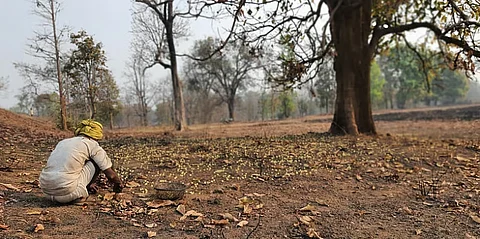

On the morning of March 19, 2025, there is silence in the Gond-dominated village of Kamepur. There is neither movement nor any noise on the main road of the village. Most houses are empty, their doors locked or bolted. The children, the elderly, and the youth of Kamepur are busy in a celebration that lasts for about a month and a half during March and April. It is the season for gathering mahua (Madhuca longifolia).
The March-April period is considered the most lucrative by the residents of Kamepur, which has a population of 339 and 74 families. The entire village, 90 per cent of which is made up of Gond families, spends this season picking mahua from 5-6 am, often forgetting to eat while giving top priority to mahua harvesting.
60-year-old Bhaduram has arrived early in the morning at the field, gathering mahua flowers under one of his 25-30 trees and repeatedly shooing away a cow that tries to eat the mahua from time to time. He has brought leftover food from last night with him. His wife prepares food in the evening for the next morning so that he has enough time to gather mahua. If food runs short, he manages by eating the fruits of the tendu tree in the field.
Three members of Bhaduram's household collect mahua from morning until evening. So far, they have collected about two quintals of mahua. Since about half of the mahua collection season has passed, they hope to gather another 2 quintals before the season ends. Bhaduram will sell the mahua for Rs 4,000-4,500 per quintal and will use this money to buy household groceries and clothes. It is estimated that a large mahua tree yields about 100 kilograms of mahua, while small and medium-sized trees yield about 40-60 kilograms of the substance.
Pawan Singh, busy gathering mahua under different trees a short distance from Bhaduram’s fields with his eight-member family, refers to this season of mahua gathering as the season of the rabi crop. In Pawan Singh's three acres (1.21 hecatres) of fields, there are 50-60 mahua trees. He does not plant any crops during the rabi season as doing that would hinder the gathering of mahua.
Explaining the rationale behind prioritising mahua over traditional crops, Pawan Singh says that in the kharif season, he plants rice and harvests about 12 quintals from three acres of land. This crop sells for around Rs 40,000. He earns a similar amount from mahua without any costs.
Singh collected a record 15 quintals of mahua in 2022 and sold it for Rs 40,000. At that time, the price of mahua was Rs 2,500 per quintal, which is significantly lower than the current price. If he collects 12 quintals of mahua throughout the season this year as well, he will earn Rs 54,000 at the current rate of Rs 4,500.
He believes that there is not much income possible from traditional rabi crops, so he does not take the risk of planting a second crop at the price of mahua. Seventy-year-old Baldev from Kamepur supports his family for the coming months solely on the income from mahua. Additionally, they prepare for the kharif crop with the income generated from mahua.
His seven mahua trees fetch him a net income of around Rs 16,000. Baldev, who is picking mahua with his five-year-old grandson, says that the income derived from mahua is most important in arranging seeds, fertilisers etc. for the kharif crop.
In Kamepur village, each family has at least 5-7 mahua trees. Many families have rights over 40-50 trees. According to village youth Rameshwar Kapil, mahua contributes 10-20 per cent of the village residents’ income. For those tribals in the village who have fewer mahua trees, the jungle’s mahua is accessible.
There is about 3,300 hectares of forest in Kamepur village, which has around 50,000 mahua trees. These trees are nothing less than a blessing for those indigenous people like Shanti Bai, who have a limited number of trees in their personal ownership. Shanti Bai has only 3 mahua trees in her field.
After collecting mahua from her fields, she heads to the forest with her mother-in-law, sister-in-law, husband, and daughter, collecting about 3 quintals of mahua in a season. She explains that the collection of mahua depends on the number of members in the family. Generally, two people collect 2-3 quintals of mahua every season, resulting in an income of about Rs 10,000.